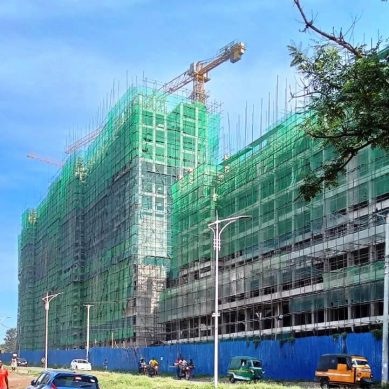
Kenya turns attention to neglected arid and semi-arid lands to expand agricultural potential
Disregarded as low potential areas by successive governments – since colonial era to present day – Kenya’s arid and semi-arid (ASAL) regions have become the East African nation’s go-to option to increase its agricultural land, produce enough food for its rising population and create employment.
Consequently, the government says it working plans for collaboration and building synergies with development partners to open up ASALs for economic investment and settlement to ease pressure on overused one-fifth of its landmass that is traditionally received priority for its high agricultural potential.
Cabinet Secretary for East African Community, ASALs and Regional Development Beatrice Moe, says engaging experts and partners from different backgrounds is key to aligning government plans to economic transformation of neglected drylands of the country.
The CS alongside Principal Secretary in the ministry Kello Harsama held a consultative meeting with development partners in the capital, Nairobi, to discuss how harmonise their plans to eliminate duplication of projects, enhance planning and align with government priorities, as well as redistribute projects in ASALs to ensure vulnerable communities’ benefit.
“The purpose of today’s consultation is to focus on activities that add value to the people, ensuring we don’t duplicate efforts but instead harmonise our activities. We aim to work on the government’s priorities while addressing the needs of the people and redistributing development in ASAL areas.
The minister she hopes the new approach will ensure a positive impact on women and children, climate change, agriculture and food security, livestock development and cross border issues, ultimately enhancing the value and appreciation of what partners are doing,” Moe explained.
The CS said the ministry is committed to working with development partners to keep track of every project in ASAL counties to ensure effective coordination and eliminate duplication.
Moe commended donors and partners for their immense contribution to the development in ASALs and the country at large, saying they have significantly improved the livelihoods of millions of people.
The CS said, “The role our donors and partners play in the development of the ASALs cannot be overstated. They have greatly improved education, health, water access, infrastructure, and livelihoods for millions of people.”
While acknowledging their efforts, the CS said, “I call upon you to continue supporting collaboration initiatives, humanitarian efforts, resilience-building, and development projects in ASALs and Regional Development Authorities to cushion affected communities and enhance sustainable socio-economic development.”
The CS acknowledged the crucial role played by the National Drought Management Authority and Regional Development Authorities in building resilience and promoting sustainable development in ASAL regions.
She appreciated their efforts in coordinating drought response, implementing early warning systems, developing risk reduction strategies, and promoting adaptive measures to address climate-related challenges.
“We recognise the importance of strengthening these institution’s capacity and deepening collaboration with donors and development partners to enhance their effectiveness,” she remarked.
Moe said her ministry has achieved its vision of ‘sustainable ASALs and integrated basin-based development for improved livelihoods’ by focusing on key priority areas, including coordination of ASALs and basin-based development, climate change mitigation, resilience building, accelerating socio-economic and infrastructure development, peacebuilding and socio-cultural integration, scaling up relief and humanitarian responses to save lives, knowledge management, and institutional capacity development.
The consultative meeting is a follow-up to the previous meeting held in November 2023, which resolved to, among other things, have clear coordination with intergovernmental agencies in developing the Regional Development Authorities Bill 2023, maximise transhumance pastoralism across boundaries, and improve markets for pastoralists.
They also discussed the need to address disconnect between national and county governments on drought management, as both levels of government, alongside development partners, hold crucial funds. The meeting addressed the importance of prioritising water conservation in ASAL regions over changes to cultural practices.
On his part, Harsama said the engagement meeting is crucial as it provides a platform to share great ideas from partners to manage resources in the ASAL region.
The PS said that in the past, many organisations worked in the counties based on the policies of their respective countries, which did not align with the realities on the ground. He added that they have now urged these organisations to prioritise resilient programmes that focus on practical solutions to the problems faced by pastoralists.
The PS said, “We have convened for the second time today to discuss various interventions. The previous meeting gave us a better understanding of the projects that development partners are undertaking. We have also realised that some partners are involved in programmes related to other ministries and state departments. As a result, we formed the ASAL Development Partners Group to coordinate activities and support humanitarian interventions in ASAL areas.”
Harsama revealed that, through the Group, partners have played a crucial role in saving the lives of vulnerable people in drought-affected counties by engaging in mobilization activities, raising funds, providing food and offering medical support.
The PS explained that it is routine for the Ministry to regularly engage development partners to update them on new activities, as well as review the progress of ongoing initiatives to assess whether they have been successful or need adjustments.
On the issue of drought, Harsama said the country is moving towards a drought-alert situation, with the Meteorological Department predicting below-average rains in ASAL areas. He indicated that 23 counties are likely to be affected, where approximately 1.8 million people are likely to directly face challenges of food, water and medical supplies.
The PS underscored the important meeting, saying it will help form the basis of discussions to chart the way forward with partners on how to fully prepare and develop interventions to mitigate the impact of this looming drought.
He said, “Communities that planted crops have failed to harvest because temperatures continue to rise, drying up water pans and diminishing pastures, which is putting additional stress on pastoralists. There is also a growing trend of food shortages in the country.”
The PS revealed that the government, through the National Disaster Response Committee, has put measures in place to ensure that pastoralists remain food secure by providing water and medical supplies.
“It is important to note that the weather is not expected to favour pastoralist areas, particularly the 23 ASAL counties, in the coming months.
However, the government, through the National Disaster Response Committee, has put in place mitigation measures in case the situation worsens,” added the PS.
- A Tell / KNA report / By Ian Chepkuto







